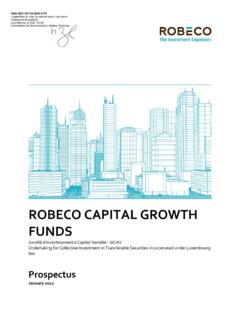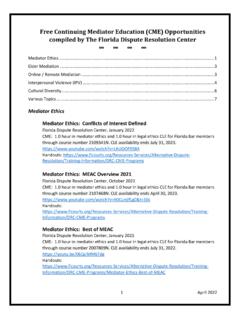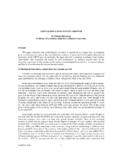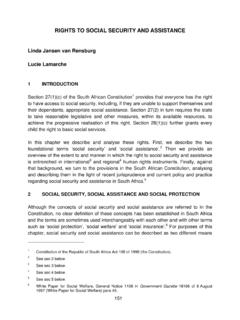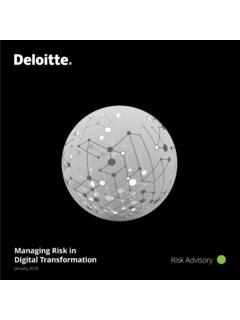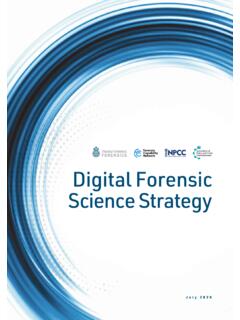Transcription of Robeco’s approach to biodiversity
1 For professional investorsWhite paperJanuary 2022 Laura BoschMichal KulakLucian PeppelenbosPeter van der WerfRobeco s approach to biodiversity Towards the integrationof nature-related risks,opportunities and impacts in our investments2 | Robeco s approach to biodiversity ContentsIntroduction 4 Foreword by WWF Netherlands 5 Why is nature loss material to Robeco? 6 Urgency for the planet 6 - Climate change and biodiversity 7 Urgency for the economy and society 9 Urgency for investors 11 What action does Robeco take on biodiversity ? 13 Our commitment 13 What s next in our roadmap 14 - Towards relevant metrics and targets 14 - Advancing strategic partnerships 15 Ongoing work 15 - SI governance and risk management 15 - Stewardship activities 15 - Investment processes 16 - Impact Analysis and Sustainable Development Goals (SDG) Framework 173 | Robeco s approach to biodiversity IntroductionThe financial sector and the asset management industry in which we sit has a crucial role to play in helping to prevent further biodiversity loss.
2 This is not something that is simply nice to have in the context of sustainable investing: it is in the long-term interest of our clients and our investment performance, along with our duty to do our best to use our financial muscle to contribute to protect the planet. For that reason we have set three strategic priorities for our Sustainable Investment strategy: Climate Change, biodiversity and Human Rights. Robeco has been addressing biodiversity issues for a number of years, through a dedicated engagement program on commodity-related deforestation, through our palm oil policy, and by assessing biodiversity as a material factor in our ESG integration process.
3 It has been part of our investment process for many years as an element of assessing environmental risk (along with opportunities) among , it is clear that there is more that we need to do, both in terms of further engagement, and in our investment decisions. It s no longer just a question of avoiding those companies that are responsible for biodiversity loss through environmentally damaging operations. We must also embrace those that are striving to protect biodiversity , directing more capital towards these sort of sustainable we can t do it alone no investor can and we need every stakeholder in society to contribute from corporates, governments to the financial sector.
4 That s why we are delighted to be partnering the World Wide Fund for Nature Netherlands in our endeavors to promote this vital project on a global scale. We will work with them using our roadmap as outlined in this white paper to use investor capital to meet our mutual objectives. Our general aim is that within the next few years we will be able to measure and steer on our contribution as an investor to the protection of biodiversity and nature in partnership with the WWF and other collaborations such as the Finance for biodiversity Pledge. In this positioning paper we describe our journey why we started it, what we have been doing, and where we aim to be.
5 We hope you will enjoy reading it, and then join us on this vital VerberkCIO Fixed Income and Sustainability4 | Robeco s approach to biodiversity Foreword by WWF-NetherlandsThe Natural world is in crisis. Never in human history has biodiversity declined as fast as it is doing so today. According to IPBES, human pressures on nature are putting a staggering one million species at risk of extinction, many within decades. Changes in land and sea use, the direct exploitation of organisms, pollution and the introduction of invasive species threaten many ecosystems.
6 However, the nature crisis is not a standalone issue. Climate change is further exacerbating the drivers of nature loss, which in turn reduces our ability to sequester carbon and thereby mitigate climate change. This negative feedback loop also reduces our ability to withstand the impacts of climate change, since degraded ecosystems do not protect us as well against natural events as healthy ecosystems. In economic terms, the impact of this nature loss is unprecedented. Ecosystems provide important services to people and businesses alike, for example through provisioning and regulating natural resources.
7 The World Economic Forum estimates that more than half of the world s economic output (USD 44tn) is at least moderately or highly dependent on nature, meaning that if natural systems collapse, so will our economic and financial systems. This is clearly an important issue for anyone involved in any sector on our planet, including its financiers. At the same time, nature offers many opportunities which are being increasingly recognized worldwide. The future of Nature and Business report estimates that a nature-positive economy can unlock USD 10 trillion of business opportunities by transforming the three economic systems that are responsible for almost 80% of nature loss, namely food, infrastructure and energy.
8 Ecosystems can be viewed as important assets. If we compare our economic system to a food chain, the financial sector can be considered to be at the top of it. Finance forms the foundation for our economic system, and enables all types of economic activities, with both positive and negative impacts on nature. The financial sector has, therefore, a crucial role to play in addressing the climate and biodiversity crisis. In order to act, the financial sector needs information to understand how nature impacts immediate financial performance, as well as the longer-term financial risks and opportunities that may arise.
9 The WWF is one of the proud initiators of the Task Force for Nature-Related Disclosure (TNFD), which aims to build a framework which will allow financial institutions to incorporate nature-related risks and opportunities into strategic planning, risk management and asset allocation decisions. It would though be strategically short sighted for financial institutions to wait until this work was concluded before acting. By starting to act now, institutions are able to dramatically reduce transitions s internal biodiversity roadmap, captured in this white paper, is a real step forward.
10 It aims to understand and address nature-related impacts and dependencies across its organization. We look forward to collaborating with Robeco to ensure robust implementation. We hope it contributes to the integration of nature into all financial decision making in order to avoid the catastrophic impacts of the crises we VermeulenDirector Green Finance, WWF-NLPartnership with World Wide Fund for Nature Netherlands (WWF-NL)Robeco and World Wide Fund for Nature Netherlands (WWF-NL) have joined forces in a new partnership from January 2022 onwards, combining their areas of expertise to highlight the urgency of biodiversity loss, build knowledge and show how investors can take action to integrate biodiversity into asset management.


